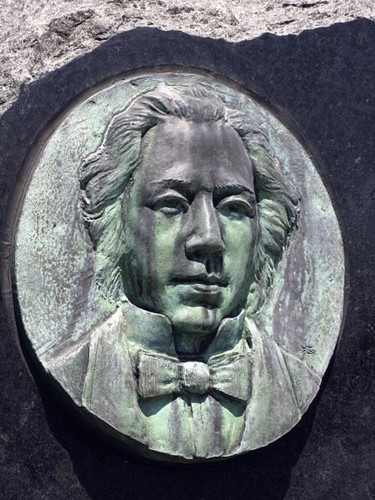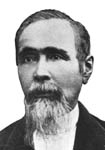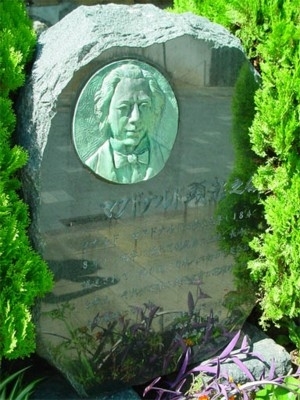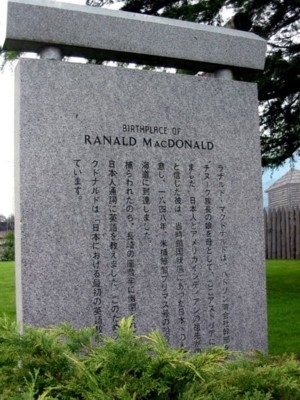 |
| Ranald MacDonald |
"Sayonara, my dear, sayonara" are not the words one would expect to hear coming from a man who was born to a prominent Scottish official and a Chinook Indian princess. But those were the final words uttered by Ranald MacDonald, as he lay dying in his niece's arms at the age of seventy.
 |
| Ranald MacDonald 1824-1894 (http://www.secstate.wa.gov/history) |
Young adventurer Ranald MacDonald (3 February 1824 - August 24, 1894) was born to Archibald MacDonald, a Hudson Bay fur trader, and Princess Raven, the daughter of Chief Comcomly, who was the leader of the Chinook people. Ranald MacDonald started and ended his life in the Pacific Northwest. MacDonald's relatives told him compelling stories about his ancestors possibly coming from Asia. This sparked a curiosity about Japan that was in the back of his mind from then on. MacDonald's father didn't appreciate his son's adventurous spirit so he sent him to Red River Academy where Ranald learned how to become a banker. This didn't please Ranald, but to appease his father, he worked in the business for a while.
Determined to learn more about Japan, MacDonald left his job as a bank clerk to become a sailor on a whaling ship. As time passed, Ranald persuaded the ship's captain to sell him a small boat, plus some essentials, so that he could pursue his dream of traveling to Japan. MacDonald was not deterred by the fact that Japan was a forbidden territory. The Japanese governor would not let anyone leave the country or enter it, and if they attempted to do so, it was punishable by imprisonment or death. The threat didn't stop this young adventurer from achieving his goal of breaking the "bamboo barrier," or discovering information about this neighboring country, or becoming an interpreter and teacher.
 |
| Monument to Ranald MacDonald in Nagasaki, Japan |
Ranald MacDonald devised a scheme to purposely capsize his boat to give the impression that he was in trouble. He had hoped the Japanese people would be sympathetic to his plight. To his dismay, his rescuers were not Japanese, but rather of Ainu origin. They did indeed rescue him and treat him kindly, but later they turned Ranald over to the samurai. He was interrogated and jailed. Later he was transported to Nagasaki, where limited trading occurred with the Dutch and Portuguese.
While in prison, MacDonald seemed to make friends with all he came into contact with. The Japanese were intrigued with his intelligence and pleasant manner. When American and British ships approached Japanese waters in order to trade, there was a quandry because there were no Japanese who spoke English. To solve this quandary, fourteen men, who had heard about the English-speaking prisoner, sought him out in order to learn the language. While confined to prison, Ranald studied Japanese and the men learned English. In ten months, Ranald was released to an American warship, which rescued stranded sailors.
 |
| Japanese language monument indicating the birthplace of Ranald MacDonald in Astoria, Oregon. |
Upon returning to the United States, MacDonald wrote a declaration to Congress explaining that Japan was a well-regulated society. Ranald wrote, "There are none to whom I feel more kindly - more grateful - than my old hosts of Japan; none whom I esteem more highly." This began communication and open trade with Japan. MacDonald continued to sail for some time, dabbled in mining, and finally set up a packing business in the Northwest. There he stayed, receiving no acknowledgment for the importance of his role in opening Japan to the United States or in teaching the men who were involved in the negotiations.
 |
| Native American and the Land of the Shogun |
Ranald MacDonald was the first American to willingly go to Japan and the first one to teach English there. He wrote a manuscript about his experiences, but couldn't get it published until 30 years after his death. How unfortunate, since he represented his country so well! His intelligence and respectful manner helped win the trust of a country that feared and distrusted the West. His curiosity about Japanese culture took precedence over any fear for his own safety. He made an important contribution to the relationship between the U.S. and Japan, and I believe he deserves more than brief mention in the history books. According to the author of Native American in the Land of the Shogun: Ranald MacDonald and the Opening of Japan, MacDonald will always be a true hero - for his vision, his humanity, and his courage in attempting the "impossible."
Page created on 7/29/2013 2:20:18 PM
Last edited 1/6/2017 9:11:52 PM
Roe, Jo Ann Ranald MacDonald: Pacific Rim Adventurer. Pullman, Washington: Washington State University Press, 1997.
Schodt, Frederik L. Native American in the Land of the Shogun: Ranald MacDonald and the Opening of Japan. Berkeley, California: Stone Bridge Press, 2003.
